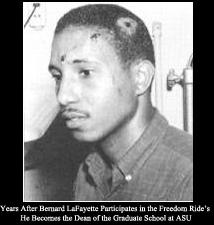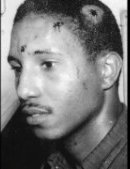

In June 1963, Bernard LaFayette was brutally beaten for his efforts to register black voters and almost died.


In June 1963, Bernard Lafayette was brutally beaten for his efforts to register black voters and almost died.
With the release of “Selma,” tremendous interest has been generated among youth activists about the struggle for voting rights as it reached its apex in March 1965.
This campaign for the ballot in Dallas County, Ala., where Selma is located, did not begin when the Rev. Dr. Martin Luther King Jr. and the Southern Christian Leadership Conference intervened in early January 1965. In fact, as the film mentions, Student Nonviolent Coordinating Committee organizers had worked in Selma for at least two years prior to SCLC’s arrival.
Prathia Hall, a SNCC field secretary, says in a first-person account in “Hands on the Freedom Plow: Personal Accounts of Women in SNCC,” “In early winter 1963, SNCC field secretary Bernard Lafayette was beaten and jailed in Selma, where he and his wife, Colia, had been working alone. Immediately afterward James Forman, executive secretary of SNCC, came to Southwest Georgia and said, ‘Come on, Prathia, we need you in Selma.’“ (University of Illinois Press, 2010, p. 470)
Hall explains, “The members of the Dallas County Voters’ League had been working there for ages; they were part of that longtime movement struggle. They had done some voting rights work, and small numbers of schoolteachers and other middle-class black people had been registered. League members also had filed some related lawsuits.”
When SNCC workers arrived in the early 1960s, they worked with high school students living in the projects. Hall stresses, “The 1965 Selma Movement could never have happened if SNCC hadn’t been there opening up Selma in 1962 and 1963. The later, nationally known movement was the product of more than two years of very careful, very slow work.”
Malcolm X’s intervention
After Dr. King and SCLC went to Selma in early 1965, Malcolm X, the founder of the Organization of Afro-American Unity (OAAU), spoke in early February at Alabama’s Tuskegee Institute, a historically African-American university 80 miles from Selma. Malcolm had broken with the Nation of Islam nearly a year earlier, pledging to work in an alliance with the Civil Rights Movement, particularly with the youth.
Fay Bellamy Powell, a former U.S. Air Force member, was recruited into SNCC in late 1964 and wound up in Dallas County, running the organization’s office and conducting press work. She found out, along with Silas Norman, also of SNCC, the details of Malcolm X’s itinerary at Tuskegee.
On Feb. 3, Powell and Norman arrived at the packed campus auditorium, which was standing room only. They got inside and spoke with Malcolm after his lecture, which consisted of an extended question-and-answer period.
These SNCC workers invited Malcolm to come to Selma the following day to address a group of youth working in the movement. Malcolm immediately agreed. They arrived at Brown’s Chapel A.M.E. Church on the morning of Feb. 4 and were swarmed by U.S. and European reporters.
Powell described this experience in Hall’s book, “Each morning Brown’s Chapel would fill with elementary, junior high and high school students. They were the core of the Selma Movement and took part in all the demonstrations. Usually these morning sessions were lively and noisy. On the day Malcolm spoke, although the church was packed with young people, there was no noise, no shuffling of feet, no coughing, no squirming. Only Malcolm’s voice could be heard.” (p. 474)
When Powell and Norman drove Malcolm to the Montgomery Airport, he said the OAAU planned to send organizers into the South and asked if SNCC would work with them. Powell reported, “Silas and I answered Malcolm’s question with an enthusiastic ‘Yes!’ and asked that he return in the not too distant future. Three weeks later, Malcolm was assassinated. That was a dream deferred.”
Roots of Black Panther Party in Alabama
After the Selma to Montgomery march, Stokely Carmichael, a SNCC field secretary later known as Kwame Ture, became the Lowndes County project director. Working with local students and community activists, they formed the Lowndes County Freedom Organization (LCFO), an independent political party whose symbol was the black panther.
Gloria House, then a University of California graduate student, went to work in Alabama as a SNCC field secretary in the summer of 1965. The Aug. 20 murder by racists of white Episcopal seminarian Jonathan Daniels in Hayneville, in Lowndes County, prompted House to return as a full-time Civil Rights worker for SNCC that fall.
House wrote in Hall’s book, “In Lowndes we organized the Lowndes County Freedom Organization, which initiated the formation of an independent black political party. Influenced by the defeat of the Mississippi Freedom Democratic Party (MFDP), we chose to create a separate political party instead of seeking admission into the Democratic Party. Jack Minnis, a researcher in SNCC’s Atlanta office, discovered a provision in the Alabama Administrative Code that allowed independent parties to enter county elections if certain stipulations were met.” (p. 509)
House noted, “SNCC workers spread the idea of independent black political parties from Lowndes County to other Alabama counties where black people constituted sizable majorities. Later I moved into Selma to help other SNCC organizers establish the freedom party of Dallas County. The fruits of our labor in the Alabama independent parties were not immediately reaped in the 1966 elections, but rather in 1970, when black people in a handful of counties won positions in local government. These officials subsequently organized a statewide coalition of independent parties, determined to win representation for black voters on a state level.” (p. 510)
The rise of Black Power
In this context, Stokely Carmichael contested and won the chairmanship of SNCC in May 1966. On June 5, James Meredith, who had desegregated the University of Mississippi in 1962, set out alone in a “March Against Fear” from Memphis, Tenn., to Jackson, Miss.
The following day he was shot and wounded by a white racist in Mississippi. In response, SCLC, the Congress on Racial Equality and SNCC, pledged to continue the march to Jackson, the state capital.
During the march through the Delta region of Mississippi, Willie Ricks, now known as Mukasa Dada, mobilized sharecroppers and youth through the slogan “Black Power.” Carmichael used the slogan in a speech on June 16 after being released from a six-hour jail stint for defying the police over erecting tents for the marchers at a local high school in Greenwood:
“We have begged the president. We’ve begged the federal government — that’s all we’ve been doing, begging and begging. It’s time we stand up and take over. Every courthouse in Mississippi ought to be burned down tomorrow to get rid of the dirt and the mess. From now on, when they ask you what you want, you know what to tell ‘em. What do you want? The crowd shouted back ‘Black Power!’ Willie Ricks jumped to the stage and lead the chorus of chants saying: ‘We want Black Power!’” (Taylor Branch, “At Canaan’s Edge: America in the King Years 1965-1968,” Simon & Schuster, 2006, p. 486)
As part of Workers World newspaper’s coverage marking the 50th anniversary of the liberation of…
From the PFLP Central Media Office The following statement from the Popular Front for the…
Newark, New Jersey Over 250 people, representing over 250 New Jersey endorsing community groups, attended…
Special to Workers World The following is a press release issued on April 24, 2025,…
dear Larry Krasner, we heard you sued Elon Musk over his corrupt million election giveaways…
Unions join forces against harassment and deportation of members When 200 immigrant workers – from…